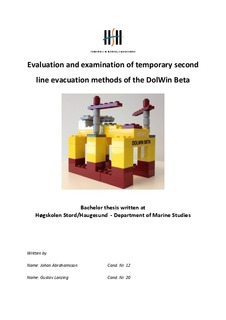Evaluation and examination of temporary second line evacuation methods of the DolWin Beta
Abstract
This project explores different means of temporary secondary evacuation that could be used for the wind platform the DolWin Beta during the towing from Haugesund to the German Bight. The platform is extraordinarily tall, 90 meters from top to bottom, and a secondary evacuation method for the personnel on board is needed if an accident would occur.
Based on reports from earlier tow operations, design drawings, interviews and research from manufactures this report focuses three different evacuation methods were found to be most suitable for the DolWin Beta platform: an evacuation chute, rappelling and ladders. These methods are evaluated in relation to technical design, simplicity, safety, how well it could handle injured personnel and how people would react when using it.
After evaluating the different temporary second line evacuations for the DolWin Beta the authors have concluded that rappelling is the most suitable system due to its capability of handling injured personnel, the flexibility of evacuation points and that personnel responsible for the evacuation will be provided.
